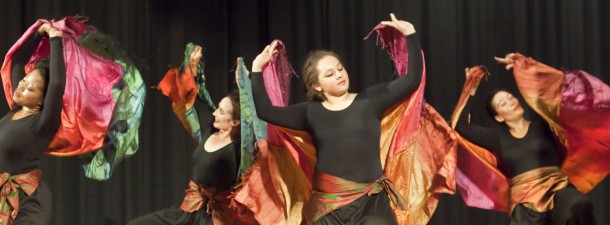Focus on the fabric
July 19, 2011
Performers with Des Moines’ Gateway Dance Theatre will use one form of art to pay homage to another Saturday when they stage “Tapestry,” a five-movement suite that celebrates the beauty and variety of textiles from around the world.
Gateway Artistic Executive Director Penny Furgerson said her love of fabric inspired the suite, which simultaneously honors textiles’ similarities and their differences across cultures.
“It’s a celebration of fabric,” Furgerson said.
Working with Sarmishtha Sarkar, Gateway choreographer and artist-in-residence, Furgerson chose a different theme for each movement. In all of them, the two aimed to capitalize on the way moving fabric can amplify gestures and evoke different states of feeling.
“We want to focus on fabrics and the moods they create,” Sarkar said.
The performance’s opening movement, “Floral Fantasy,” celebrates the way that artisans of many cultures adorn fabrics with floral patterns.
In the second movement, called “Woven Magic,” dancers’ paths intersect each other to convey the image of fabric being loomed. “Cubo,” a composition for electric horn by Iowa musician Paul Micich, will accompany this part of the performance.
The third movement, “Silken Saga,” explores the near-universal association of silk with luxury.
With the performance’s fourth movement, “Rich in Rituals,” dancers move from a focus on fabric itself to the roles it plays in people’s lives. This movement examines the way people use fabrics to mark milestones such as birth, marriage and death.
The final movement, “Riveting Ramp,” uses the concept of a fashion runway as its starting point, showing a few of the innumerable ways people clothe themselves with fabrics.
The performance will feature fabrics from Guatemala, China, Japan, India, the United States and several African countries. Music as multicultural as the fabrics onstage will accompany each movement: the performance score is an assemblage of African-American gospel, classical Indian and Afro-Caribbean pieces.
Furgerson and Sarkar deliberately avoided choreography that drew too narrowly on a single style of dance. Doing so, Furgerson believes, would have pulled textiles out of the spotlight.
“We’re not trying to identify with a specific culture,” Furgerson said. “We’re just trying to show the beauty.”
Both the content of “Tapestry” and the method by which it was developed are consistent with the project Furgerson and her late husband Lee embarked on when they founded Gateway Dance Theatre in 1972: to connect people of different cultures and backgrounds through art.
Giving two instances of the cultural exchange she spoke of, Furgerson said that, as the show was developing, a Japanese woman and a Native American woman both brought her types of fabric that are widely used among people of their respective cultures.
“There’s a lot of sharing going on,” Furgerson said.
Priti Nambisan, vice president of the India Cultural Association of Central Iowa, echoed Furgerson’s sentiments.
“She brings together people from different backgrounds and different areas,” Nambisan said. “She learns from them and they learn from her.”
As well as seeing the “Tapestry” dance suite, audience members will get a chance to see Sarmishtha Sarkar demonstrate a form of dance called Bharatanatyam. Developed more than four millennia ago, it is one of India’s oldest styles of dance. Sarkar said that because it places equal emphasis on body movement and facial expressions, the style is well suited to telling stories.
Nambisan said she was eager to see Furgerson and Sarkar’s performance this weekend.
“I’m looking forward to seeing how the whole thing pulls together.”
“Tapestry”
What: A five-movement dance suite that celebrates textile art
Where: Ames City Auditorium, 515 Clark Avenue
When: Saturday, July 23 at 7:15 p.m.
Cost: $8 for students, $12 for Gateway Dance Theatre members and $14 for nonmembers. Buy tickets before April 22 to receive a $2 discount.







